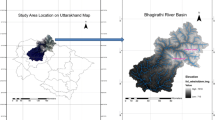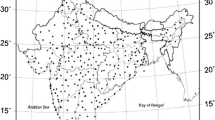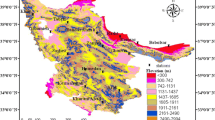Abstract
The current research reports a univariate analysis of 2 important climatological parameters surface air temperature and rainfall over North East India over annual scale characterized by various degrees of non-linearity. An Autocorrelation study reveals that although the surface air temperature is characterized by an approximate sinusoidal pattern, the rainfall has no apparent pattern. As both the time series have continuous random variables associated with it we need a discretization to make them suitable for study in time domain. First, we test for Markovian behavior against serial independence. By appropriate discretization of both the time series the transition probabilities are computed to test for Two State Markov Chain model with different orders. A chi square test reveals that although the surface air temperature time series follows the Markov Chain model of 1st Order, the annual rainfall is serially independent. The steady state transition probabilities are computed for surface air temperature and subsequently autoregressive models upto order 4 with the help of Yule-Walker Equations. It was further observed that the 2nd order model satisfied the stationarity conditions. Subsequently to have a general overview of the stationarity, Unit Root Test is carried out for both the time series. For surface air temperature a root was found to exist inside the circumference of the unit circle while for rainfall time series finds a root of the characteristic equation outside unit circle. This indicates stationarity of the surface air temperature time series for its 1st order differences and non-stationarity of rainfall time series. Based on this, Autoregressive Integrated Moving Average (ARIMA(p,q,d)) model is fitted to the rainfall time series for various orders of Autoregression and differencing. Subsequently the performance of ARIMA has been compared to univariate artificial neural network model with 4 successive realizations as predictor and the 5th one as predictand. In order to test the relative contributions to these meteorological phenomenon, maximization of Shannon entropy is used.

















Similar content being viewed by others
References
Anandhi A, Perumal S, Gowda PH, Knapp M, Hutchinson S, Harrington J Jr, Murray L, Kirkham MB, Rice CW (2013) Long-term spatial and temporal trends in frost indices in Kansas, USA. Climatic Change 120:169–181. https://doi.org/10.1007/s10584-013-0794-4
Barnett TP, Preisendorfer R (1987) Origins and levels of monthly and seasonal forecast skill for United States surface air temperatures determined by canonical correlation analysis. Mon Weather Rev 115:1825–1850
Biazar SM, Ferdosi FB (2020) An investigation on spatial and temporal trends in frost indices in northern Iran. Theor Appl Climatol 141:907–920. https://doi.org/10.1007/s00704-020-03248-7
Biazar S, Ghorbani M, Darbandi S (2018) Used from Entropy theory and Gamma test in the determination input variables for daily evaporation estimation. Iranian J Ecohydrol 5(2):535–549. https://doi.org/10.22059/ije.2017.239442.699
Calvo JC, Gregory JD (1994) Predicting monthly and annual air temperature characteristics in North Carolina. J Appl Meteorol 33:490–499
Ceschia M., Linussio A. & Micheletti S., Trend analysis of mean monthly maximum and minimum surface temperatures of the 1951–1990 period in Friuli-Venezia Giulia, Il Nuovo Cimento C 17, pages511–521(1994)
Chaudhuri S, Chattopadhyay S (2001) Measure of CINE-a relevant parameter for forecasting pre-monsoon thunderstorms over GWB. Mausam 52:679–684
Chaudhuri S, Chattopadhyay S (2005) Neuro-computing based short range prediction of some meteorological parameters during the pre-monsoon season. Soft Comput 9:349–354
Chattopadhyay S (2007) Feed forward artificial neural network model to predict the average summer-monsoon rainfall in India. Acta Geophysica 55:369–382
Chou C-M (2007) Efficient nonlinear modeling of rainfall-runoff process using wavelet compression. J Hydrol 332:442–455
Colman AW, Davey MK (2003) Statistical prediction of global sea-surface temperature anomalies. Int J Climatol 23:1677–1697
Cracknell AP, Varotsos CA (2007) International Journal of Remote Sensing 28(10):2071–2072. https://doi.org/10.1080/01431160701347147
Das PJ, Goswami DC (2003) Long-term variability of rainfall over Northeast India. Indian Journal of Landscape Systems and Ecological Studies 26(1):1–20
Das PJ. 2004. Rainfall regime of northeast India: a hydrometeorological study with special emphasis on the Brahmaputra basin, Unpublished PhD thesis, Gauhati University, Assam, India
Dastidar AG, Ghosh D, Dasgupta S, De UK (2010) Higher order Markov chain models for monsoon rainfall over West Bengal, India. Indian J Radio Space Phys 39:39–44
Dimri AP, Mohanty UC (2009) Simulation of mesoscale features associated with intense western disturbances over western Himalayas. Meteorological Applications: A journal of forecasting, practical applications, training techniques and modelling 16(3):289–308
Dimri AP, Niyogi D, Barros AP, Ridley J, Mohanty UC, Yasunari T, Sikka DR (2015) Western disturbances: a review. Rev Geophys 53(2):225–246
Efstathiou MN, Varotsos CA (2010) On the altitude dependence of the temperature scaling behaviour at the global troposphere. Int J Remote Sens 31(2):343–349
Elliott WP, Angell JK (1987) The relation between Indian monsoon rainfall, the southern oscillation, and hemispheric air and sea temperature: 1884–1984. J Clim Appl Meteorol 26:943–948
Frias MD, Fernandez J, Saenz J, Rodriguez-Puebla C (2005) Operational predictability of monthly average maximum temperature over the Iberian Peninsula using DEMETER simulations and downscaling. Tellus 57A:448–463
Gardner MW, Dorling SR (1998) Artificial neural networks (the multilayer perceptron)-a review of applications in the atmospheric sciences. Atmos Environ 32:2627–2636
Ghosh Hajra N, Kumar R (1999) Seasonal variation in photosynthesis and productivity of young tea. Exp Agric 35:71–85
Gilbert CG (1953) An aid for forecasting the minimum temperature at Denver, Colo. Mon Weather Rev 81:233–245
Griffiths GM, Chambers LE, Haylock MR, Manton CMJ, Nicholls N, Beak BH, Choi DY, Della-Marta PM, Gosai FA, Iga AN, Lata GR, Laurent HV, Maitrepierre IL, Nakamigawa JH, Ouprasitwong KN, Solofa LD, Tahani ML, Thuy NDT, Tibig OL, Trewin PB, Vediapanq BK, Zhir P (2005) Change in mean temperature as a predictor of extreme temperature change in the Asia–pacific region. Int J Climatol 25:1301–1330
Hill T, Marquez L, O'Connor M, Remus W (1994) Artificial neural network models for forecasting and decision making. Int J Forecast 10(1):5–15
Hingane LS, Kumar KR, Murty BVR (1985) Long term trends of surface air temperature in India. Int J Climatol 5:521–528
Hsieh WW, Tang B (1998) Applying neural network models to prediction and data analysis in meteorology and oceanography. Bulletin of American Meteorological Society 79:1855–1870
Hussain M (1984) Estimation of global and diffuse irradiation from sunshine duration and atmospheric water vapour content. Sol Energy 33:217–220
IPCC (2007) Climate change 2007—synthesis report (https://www.ipcc.ch/site/assets/uploads/2018/02/ar4_syr_full_report.pdf)
Jhajharia D, Shrivastava SK, Sarkar D, Sarkar S (2009) Temporal characteristics of pan evaporation trends under the humid conditions of Northeast India. Agric For Meteorol 149:763–770
Jumarie, G., 2013. Maximum entropy, information without probability and complex fractals: classical and quantum approach (Vol. 112). Springer Science & Business Media.
Kangieser PC (1959) Forecasting minimum temperatures on clear winter nights in an arid region. Mon Weather Rev 87:19–28
Karmakar S, Goswami S, Chattopadhyay S (2019) Exploring the pre- and summer-monsoon surface air temperature over eastern India using Shannon entropy and temporal Hurst exponents through rescaled range analysis. Atmospheric Research 217(1):57–62
Khan S, Ganguly AR, Saigal S (2005) Detection and predictive modeling of chaos in finite hydrological time series. Nonlinear Process Geophys 12:41–53
Klein WH, Lewis F, Hammons GA (1971) Recent developments in automated max/min temperature forecasting. J Appl Meteorol 10:916–920
Klein WH, Lewis F (1970) Computer forecasts of maximum and minimum temperatures. J Appl Meteorol 9:350–359
Klein WH, Marshall F. 1973. Screening improved predictors for automated max/min temperature forecasting. Preprints of 3rd Conference on Probability and Statistics. American Meteorological Society: Boulder, CO; 36–43
Kumar KK, Kumar KR, Pant GB (1997) Pre-monsoon maximum and minimum temperatures over India in relation to the summer monsoon rainfall. Int J Climatol 17:1115–1127
Kumar KK, Rajagopalan B, Cane MA (1999) On the weakening relationship between the Indian monsoon and ENSO. Science 284:2156–2159
Lesne A (2014) Shannon entropy: a rigorous notion at the crossroads between probability, information theory, dynamical systems and statistical physics. Math Struct Comput Sci 24(3). https://doi.org/10.1017/S0960129512000783
Lianchun S, Cannon AJ, Whitfield PH (2007) Changes in seasonal patterns of temperature and precipitation in China during 1971–2000. Advances in Atmospheric Sciences 24:459–473
Liu Y, Liu C, Wang D (2011) Understanding atmospheric behaviour in terms of entropy: A review of applications of the second law of thermodynamics to meteorology. Entropy 13:211–240. https://doi.org/10.3390/e13010211
Ludlam F (1980) Clouds and storms. Pennsylvania State University Press, Pennsylvania
Luterbacher J, Dietrich D, Xoplaki E, Grosjean M, Wanner H (2004) European seasonal and annual temperature variability, trends, and extremes since 1500. Science 303:1499–1503
Mandal M, Mohanty UC, Sinha P, Ali MM (2007) Impact of sea surface temperature in modulating movement and intensity of tropical cyclones. Nat Hazards 41:413–427
Mantis HT, Dickey WW. 1945. Objective methods of forecasting the daily minimum and maximum temperature. Report number 4, U.S. Army Air Force, Weather Station, New York University
Massie DR, Rose MA (1997) Predicting daily maximum temperatures using linear regression and eta Geopotential thickness forecasts. Weather Forecast 12:799–807
Mathison C, Wiltshire A, Dimri AP, Falloon P, Jacob D, Kumar P, Moors E, Ridley J, Siderius C, Stoffel M, Yasunari T (2013) Regional projections of north Indian climate for adaptation studies. Sci Total Environ 468:S4–S17
Mearns LO, Katz RW, Schneider SH (1984) Extreme high-temperature events: changes in their probabilities with changes in mean temperature. J Appl Meteorol 23:1601–1613
Meehl GA, Karl T, Easterling DR, Changnon S, Pielke R Jr, Changnon D, Evans J, Groisman PY, Knutson TR, Kunkel KE, Mearns LO, Parmesan C, Pulwarty R, Root T, Sylves RT, Whetton P, Zwiers F (2000) An introduction to trends in extreme weather and climate events: observations, socio-economic impacts, terrestrial ecological impacts, and model projections. Bull Am Meteorol Soc 81(3):413–416
Mirza MMQ, Warrick RA, Ericksen NJ, Kenny GJ (1998) Trends and persistence in precipitation in the Ganges, Brahmaputra and Meghna basins in South Asia. Hydrol Sci J 43:845–858
Pant GB, Kumar KR (1997) Climates of south Asia. Wiley-Blackwell
Pattanaik DR (2007) Variability of convective activity over the North Indian Ocean and its associations with monsoon rainfall over India. Pure Appl Geophys 164:1527–1545
Peterson RE, Mehta KC. 1995. Tornadoes of the Indian subcontinent. Paper presented at 9th International Conference on Wind Engineering, International Association of Wind Engineering , New Delhi, Indiaxs
Rehman S, Husain T, Halawani TO (1990) Application of one-dimensional planetary boundary layer model to the regional transport of pollutants—a case study. Atmos Res 25:521–538
Roulston MS, Smith LA (2002) Evaluating probabilistic forecasts using information theory. Mon Weather Rev 130(6):1653–1660
Said SAM (1992) Degree-day base temperature for residential building energy prediction in Saudi Arabia. ASHRAE Trans 98:346–353
Shrestha AB, Wake CP, Mayewski PA, Dibb JE (1999) Maximum temperature trends in the Himalaya and its vicinity: an analysis based on temperature records from Nepal for the period 1971–1994. J Clim 12:2775–2786
Sivakumar B (2005) Chaos in rainfall: variability, temporal scale and zeros. J Hydroinf 7:175–184
Spreen WC (1956) Empirically determined distributions of hourly temperatures. J Atmos Sci 13:351–355
Tang B, Hsieh WW, Monahan AH, Tangang FT (2000) Skill comparisons between neural networks and canonical correlation analysis in predicting the equatorial Pacific Sea surface temperatures. J Clim 13:287–293
Tasadduq I, Rehman S, Bubshait K (2002) Application of neural networks for the prediction of hourly mean surface temperatures in Saudi Arabia. Renew Energy 25(4):545–554
Tettey M, Oduro FT, Adedia D, Abaye DA (2017) Markov chain analysis of the rainfall patterns of five geographical locations in the south eastern coast of Ghana. Earth Perspect 4(1):6. https://doi.org/10.1186/s40322-017-0042-6
Van Loon H, Jenne RL (1975) Estimates of seasonal mean temperature, using persistence between seasons. Mon Weather Rev 103:1121–1128
Varotsos CA, Efstathiou MN, Cracknell AP (2013) Atmos Chem Phys 13(10):5243–5253
Varotsos CA, Milinevsky G, Grytsai A, Efstathiou M, Tzanis C (2008) Scaling effect in planetary waves over Antarctica. Int J Remote Sens 29:2697–2704
Vil'fand RM, Tishchenko VA, Khan VM (2007) Statistical forecast of temperature dynamics within month on the basis of hydrodynamic model outputs. Russ Meteorol Hydrol 32:147–153
Vries A, Risco CA (n.d.) Trends and seasonality of reproductive performance in Florida and Georgia dairy herds from 1976 to 2002
Weston KJ (1972) The dry-line of northern India and its role in cumulonimbus convection. Quarterly Journal of Royal Meteorological Society 98:469–471
Wijeratne MA (1992) Vulnerability of Sri Lanka tea production to global climate change. Water Air Soil Pollut 92:87–94
Wilks DS (2006) Statistical Methods in the Atmospheric Sciences. Int Geophys Ser 91
Willmott CJ, Matsuura K (1995) Smart interpolation of annually averaged air temperature in the United States. J Appl Meteorol 34(12):2577–2586
Xoplaki E, González-Rouco JF, Luterbacher J, Wanner H (2003) Mediterranean summer air temperature variability and its connection to the large-scale atmospheric circulation and SSTs. Clim Dyn 20(7-8):723–739
Yamane Y, Hayashi T (2006) Evaluation of environmental conditions for the formation of severe local storms across the Indian subcontinent. Geophys Res Lett 33:L17806. https://doi.org/10.1029/2006GL026823
Zuidema P (2003) Convective clouds over the bay of Bengal. Mon Weather Rev 131:780–798
Acknowledgements
The authors acknowledge the supportive comments from the anonymous reviewers.
Author information
Authors and Affiliations
Corresponding author
Additional information
Communicated by: H. Babaie
Publisher’s note
Springer Nature remains neutral with regard to jurisdictional claims in published maps and institutional affiliations.
Rights and permissions
About this article
Cite this article
Ray, S.N., Chattopadhyay, S. Analyzing surface air temperature and rainfall in univariate framework, quantifying uncertainty through Shannon entropy and prediction through artificial neural network. Earth Sci Inform 14, 485–503 (2021). https://doi.org/10.1007/s12145-020-00555-5
Received:
Accepted:
Published:
Issue Date:
DOI: https://doi.org/10.1007/s12145-020-00555-5




